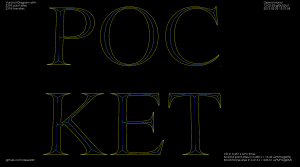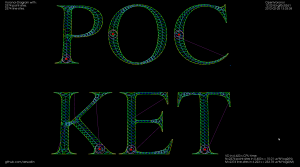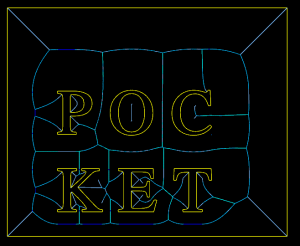My first attempt at MA-pocketing only worked when the medial axis of the pocket was a tree (a connected acyclig graph).
I've now extended this to work with pockets consisting of many parts which ha a MA consisting of multiple connected components. There's also simple support for when the MA has cycles, such as seen in "P" and "O" above. With a large cut-width the toolpath looks like this:
Each component of the pocket starts at the red dot with a pink spiral that clears the largest MIC of the pocket. The rest of the pocket is then "scooped out" using green cut-arcs connected with cyan (tool down) or magenta (tool up, at clearance height) rapid moves.
Instead of clearing the interior of letters we can also clear a pocket around the letters. The MA then looks like this:
This video shows quite a lot of "air-cutting". This is because the algorithm only keeps track of the previously cleared area behind the MIC that is currently being cleared. When we come to the end of a cycle in the MA the algorithm does not know that in fact MICs in front of the current MIC have already been cleared.



in ma-pocket_2 it looks like some of the paths on the top bar of T and E go outside the letter. I recall from an earlier blog entry that this is supposed to be prevented by the way the cutting loops are designed. Any idea what's going on here?
Hi Jeff,
If the medial-axis is correct then the MICs (maximal inscribed circles) are contained within the pocket boundary. These are the large green arc-cuts.
The errors occur when we rapid from one cut-move to the next one, or on the bi-tangent lead-in/out moves before a cut-arc. This seems to happen at places where the pocket rapidly narrows or widens. I'm not sure how to fix this yet..